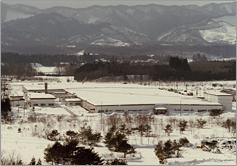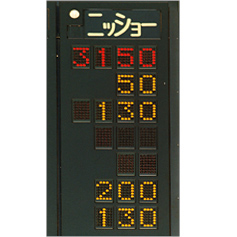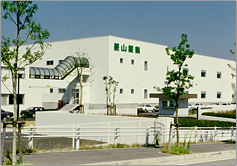Corporate InformationHistory

1947–1963
Establishment
NIPRO was founded in 1947 as a light bulb recycling business.
In 1954, Nihon Glass Shoji Co. Ltd. (current NIPRO CORPORATION) was established, and began marketing glass tubes for ampoules. Our products included not only medical glass but also small light bulbs and glass for vacuum flasks. The company also entered the supermarket business (later Nissho Store).
- 1947
- Our founder, Sano Minoru, was just 20 when he started a light bulb recycling business in Otsu, Shiga Prefecture, with the assistance of Biwako Natural Gas Co., Ltd.
- 1950
- Biwako Denkyu Seisakujo LLC was established in Otsu, Shiga Prefecture, and began trading with the Glass Section of NEC Corporation (later Nippon Electric Glass Co., Ltd.).
- 1954
- Nihon Glass Shoji Co. Ltd. was established in Shimogyo-Ku, Kyoto, and started selling glass tubes for ampoules and pill bottles.

Automation of ampoule processing - 1959
- Head office moved to Oyodo-Ku (current Kita-Ku), Osaka.
- 1960
- Otsu Factory (current Biwako Factory in Kusatsu, Shiga Prefecture) was built in Otsu, Shiga Prefecture, and started production of glass bottles and small light bulbs.
- 1963
- Automatic machines for processing inner flasks of vacuum flasks were developed, and the company began selling glass for vacuum flasks.
The company also entered the supermarket business.
Development of automatic processing machines for inner flasks of vacuum flasks 
Start of supermarket business
1964–1973
Expansion into the Medical Industry
With the success of the glass and supermarket businesses, the company entered the medical industry through capital participation and corporate acquisition.
- 1965
- The company began selling infusion kits for pharmaceutical companies, starting its expansion into the medical device industry.
- 1966
- The company opened its Tokyo Business Office (current Technical Sales Department of the PharmaPackaging Division) in Chiyoda-Ku, Tokyo.
- 1969
- Tomisawa Manufacturing Co., Ltd. (current Nipro Medical Industries Co., Ltd.) was acquired, and production of medical devices started.

Assembly of injection needles at Nipro Medical Industries Co., Ltd. - 1972
- Nihon Plastic Specialties Co., Ltd. (corporate name changed to NIPRO Co., Ltd. in the same year) was purchased to handle domestic sales of medical devices.

Start of sales of medical devices in Japan
1974–1983
Expansion into the Medical Business
In this period, NIPRO shifted its focus to the medical business, with an emphasis on dialyzers (artificial kidneys). At first, NIPRO manufactured coil dialyzers, and then was one of the first companies in Japan to begin manufacturing hollow fiber dialyzers. Since this time, the company has been serving the needs of many patients in need of hemodialysis. The company also opened the Technological Development Center (current Research & Development Laboratory) in Kusatsu, Shiga Prefecture, and the Odate Factory in Odate, Akita Prefecture. This established the company as an integrated manufacturing system, from research and development through to production of medical devices.
- 1974
- Nipro Medical Industries Co., Ltd. began manufacturing disposable syringes and coil dialyzers.
- 1975
- The company began manufacturing blood tubing, infusion kits, and hollow fiber dialyzers.
- 1976
- The company began manufacturing vacuum blood collection tubes and catheters.
- 1977
- The company changed its corporate name to Nissho Corporation.
Technological Development Center (current Research & Development Laboratory) was established in Kusatsu, Shiga Prefecture.

Technological Development Center (current Research & Development Laboratory) - 1978
- The company began the joint development of cellulose acetate hollow fiber membranes with a major material manufacturer.
- 1981
- NIPRO Odate Factory was built in Odate, Akita Prefecture.

Odate Factory - 1983
- The company began supplying dialyzers and related products to a major medical device distributor in the United States.
The company also started manufacturing medical rubber stoppers.
1984–1993
Expansion Overseas of the Medical Business and Launch of the Pharmaceutical Business
The quality and reliability of NIPRO’s medical devices were evaluated highly by overseas companies, and the company started to do business with companies all over the world. In 1988, the company established its first overseas manufacturing and marketing base in Thailand, thus embarking on the globalization of its business.
In addition, the company fully launched its pharmaceutical business to address increasing needs for kits combining pharmaceuticals and medical devices in clinical settings. This established the company’s three business pillars—medical devices, pharmaceuticals, and glass—that it has maintained to this day.
- 1984
- The company began supplying insulin injection needles to a major pharmaceutical company in Denmark.
- 1985
- The company began supplying vacuum blood collection needles to a major medical device company in the United States.
The Japan-U.S. MOSS talks promoted the manufacture of medical device kits. - 1986
- The company began supplying arteriovenous fistula (AVF) needles for dialysis to a major medical device company in Sweden.
- 1987
- The company was listed on the Second Section of the Osaka Securities Exchange.

The company was listed on the Second Section of the Osaka Securities Exchange. - 1988
- The cellulose triacetate (CTA) dialyzer, an international commodity, was developed.
The company acquired capital in Hishiyama Pharmaceutical Corporation (current Nipro Pharma Corporation) to expand its business into pharmaceuticals.
Nissho Nipro Corporation (current Nipro (Thailand) Corporation Limited) was established in Thailand.
Nissho Nipro Corporation (current Nipro (Thailand) Corporation Limited) - 1990
- The company was designated on the First Section of the Osaka Securities Exchange.
Hishiyama Pharmaceutical Corporation Ise Plant (current Nipro Pharma Corporation Ise Plant) was constructed.
A full (integrated) kit of antibiotics was developed with a major pharmaceutical manufacturer.
Hishiyama Pharmaceutical Corporation Ise Plant (current Nipro Pharma Corporation Ise Plant) - 1991
- Nissho Nipro Europe N.V. (current Nipro Medical Europe N.V.) was established in Belgium.